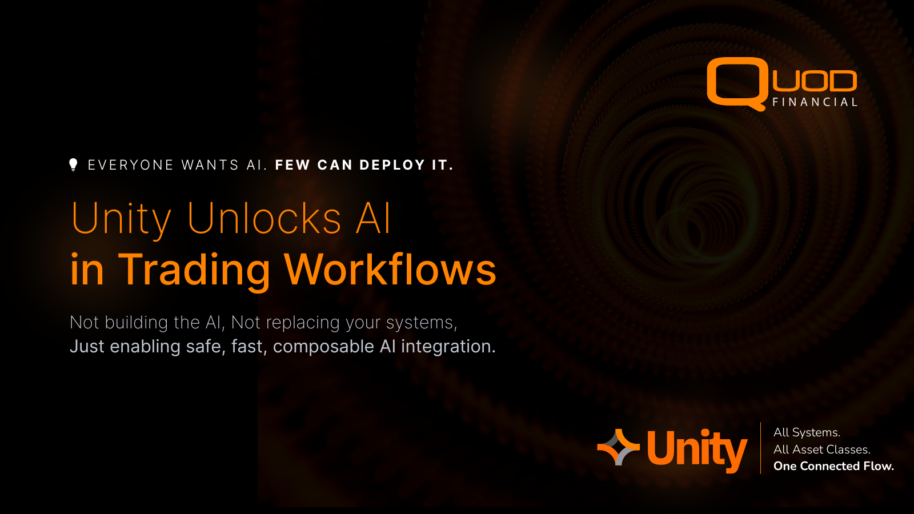
Imagine being a Head of Trading who can add a trade toxicity analysis on client trades in a single afternoon. No IT roadmap, no six-month project plan, just a direct line from idea to live integration.
For most firms, that sounds impossible. AI ambitions collide daily with legacy system modernization, siloed data, and rigid workflows. But with Unity, that wall starts to crumble, turning AI from a PowerPoint dream into a live decision engine embedded in your trade lifecycle workflow.
In every innovative firm today, there’s an appetite to explore AI, whether it’s using machine learning for trade toxicity, predictive analytics for client behavior, or AI models to enhance risk oversight. But between that ambition and a working prototype lies a familiar wall: legacy system modernization.
What if, instead of building another multi-year IT roadmap, you could plug an AI trading decision into your trade lifecycle workflow in an afternoon?
The AI Ambition vs. the IT Reality
AI is now table stakes in capital markets. Yet most firms find that moving from an AI idea to a live, production-grade integration takes years.
Siloed systems, fragmented data models, and hard-coded workflows make it impossible to experiment quickly. Every new idea requires coordination between technology, compliance, and trading teams. Even a small proof of concept, such as a trade toxicity analysis, often demands custom integration and lengthy QA cycles.
“Legacy systems, with their monolithic designs and outdated codebases, are ill-equipped for this environment. They lack the flexibility and interoperability needed to thrive in a modern trading environment.” notes RapidAddition in their article on legacy platform modernisation.
And while AI thrives on clean, contextualized data, most legacy systems are not built to expose it easily. This is where Unity changes the equation.
Unity: The Bridge Between Systems and AI
Unity is not a dashboard on top of existing systems. It is a bridge that exposes standardized trading data and allows trading business logic to be modified or extended, including by AI, without rewriting the core systems underneath.
By normalizing interfaces for trades, orders, positions, and risk, Unity makes data instantly consumable by any AI or ML platform. Its pre-trade risk engine then allows decisions from AI models to interact directly with live workflows.
To understand where Unity fits, here’s how it compares to traditional approaches:
| Layer | What It Does | Limitation | What Unity Adds |
| Traditional Middleware | Moves and transforms messages between systems, for example, trade data from OMS to risk engine. | Handles connectivity, not logic. It cannot easily support AI-powered trade decisioning or contextual workflows. | Unity includes middleware capabilities together with a trading business logic layer that lets firms compose or extend logic at runtime. |
| API Gateway | Exposes REST or FIX APIs securely to external applications. | Useful for access management, but it does not normalize or contextualize trading data. | Unity provides standardized interfaces for orders, trades, risk, and positions, ready for AI consumption. |
| Unity | Acts as a modular trading integration and logic layer that bridges systems and AI tools. It normalizes data and allows firms to insert, test, or swap logic dynamically, such as adding a trade toxicity analysis. | Enables rapid innovation without rebuilding core infrastructure. |
Innovation at Speed
Traditional change usually means large transformation programs. Unity enables composition instead: small, testable pieces of logic that can be added or removed without disrupting production systems.
Now, imagine again being a Head of Trading who can add a trade toxicity analysis on client trades in a single afternoon. Here is how it could work:
- Unity exposes live order and trade data.
- An external AI model, such as ChatGPT, an in-house LLM, or a machine learning model toxicity model, analyses patterns and flags high-risk client trades.
- The result feeds back into Unity’s rules engine.
- Unity executes the decision to block, flag, or adjust, without any system rebuild.
The winners in AI-driven trading will not be those who build the biggest models, but those who can test, adapt, and deploy ideas the fastest.
—
About Quod Financial
Quod Financial delivers advanced multi-asset trading technology through Unity — a modular, cross-asset architecture designed to interconnect the full order lifecycle. Unity provides normalized integration across all trade lifecycle workflows, empowering financial institutions to automate, customize, and scale their trading infrastructure without disruption.
Built on Unity, Quod’s product suite includes high-performance OMS, EMS, Smart Order Routing (SOR), Algorithmic Trading, Internalization of Liquidity, and dynamic market connectivity — all accessible through a flexible, data-driven, and AI-enhanced platform.
For more information, visit: www.quodfinancial.com
Quod Marketing | +44 20 7997 7020 | marketing@quodfinancial.com

